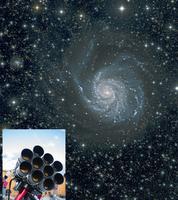
In this talk I will describe some early results from the Toronto/Yale
Dragonfly Telephoto Array (a.k.a. Dragonfly), a robotic imaging system
optimized for the detection of extended ultra low surface brightness
structures. Dragonfly is comprised of multiple (expensive!) commercial 400 mm
f/2.8 telephoto lenses which have high performance sub-wavelength nanostructure
optical coatings designed to minimize scattered light and ghosting. This
instrument is optimized to explore the night sky in a totally different
parameter space from the Hubble or Keck telescopes, and in its chosen niche no
other telescope can touch it: Dragonfly's wide-field low surface brightness
imaging performance is capable of directly imaging low surface brightness
structures (such as galactic streams, galaxy stellar halos and faint dwarf
galaxies) about 10x fainter than is possible with conventional telescopes. In
this talk I'll show some early results, mainly focusing on the properties of
ultra-faint stellar halos, though I'll also report the discovery of a new class
of ghostlike galaxies that are as big as the Milky Way but have about
1/1000 of its mass.
 In this talk I will describe some early results from the Toronto/Yale
Dragonfly Telephoto Array (a.k.a. Dragonfly), a robotic imaging system
optimized for the detection of extended ultra low surface brightness
structures. Dragonfly is comprised of multiple (expensive!) commercial 400 mm
f/2.8 telephoto lenses which have high performance sub-wavelength nanostructure
optical coatings designed to minimize scattered light and ghosting. This
instrument is optimized to explore the night sky in a totally different
parameter space from the Hubble or Keck telescopes, and in its chosen niche no
other telescope can touch it: Dragonfly's wide-field low surface brightness
imaging performance is capable of directly imaging low surface brightness
structures (such as galactic streams, galaxy stellar halos and faint dwarf
galaxies) about 10x fainter than is possible with conventional telescopes. In
this talk I'll show some early results, mainly focusing on the properties of
ultra-faint stellar halos, though I'll also report the discovery of a new class
of ghostlike galaxies that are as big as the Milky Way but have about
1/1000 of its mass.
In this talk I will describe some early results from the Toronto/Yale
Dragonfly Telephoto Array (a.k.a. Dragonfly), a robotic imaging system
optimized for the detection of extended ultra low surface brightness
structures. Dragonfly is comprised of multiple (expensive!) commercial 400 mm
f/2.8 telephoto lenses which have high performance sub-wavelength nanostructure
optical coatings designed to minimize scattered light and ghosting. This
instrument is optimized to explore the night sky in a totally different
parameter space from the Hubble or Keck telescopes, and in its chosen niche no
other telescope can touch it: Dragonfly's wide-field low surface brightness
imaging performance is capable of directly imaging low surface brightness
structures (such as galactic streams, galaxy stellar halos and faint dwarf
galaxies) about 10x fainter than is possible with conventional telescopes. In
this talk I'll show some early results, mainly focusing on the properties of
ultra-faint stellar halos, though I'll also report the discovery of a new class
of ghostlike galaxies that are as big as the Milky Way but have about
1/1000 of its mass.

